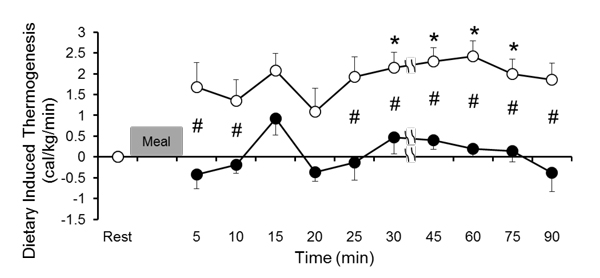Researchers at Tokyo Institute of Technology use quantitative studies to identify significant correlations between thoroughly chewing food and the energy expenditure related to food digestion, absorption and storage.
The benefits of eating slowly and chewing thoroughly have been proposed for over a century. Now Yuka Hamada Hideaki Kashima and Naoyuki Hayashi have made quantitative studies of the relation between chewing and physiological parameters subsequent to a meal such as circulation and energy expenditure. As they point out “If chewing alters digestion-induced thermogenesis, its importance should be incorporated into weight management strategies.”
The researchers based at Kyushu University and Tokyo Institute of Technology in Japan monitored 11 healthy normal-weight test subjects given 100 kcal of solid food and 10 given 300 kcal of solid food. Both sets of subjects undertook two trials - one where they swallowed the food as rapidly as possible and one where they chewed as many times as possible.
The energy expenditure associated with digestion, absorption and storage of food, known as diet-induced thermogenesis, was significantly higher when the food was eaten slowly with a high number of chews. Previous research has indicated that increased orosensory stimulation increases this energy expenditure, which may be linked to the effects of leisurely and careful food consumption on diet-induced thermogenesis.
The researchers measured oxygen uptake and body mass to calculate the diet-induced thermogenesis and also monitored blood flow around the digestive organs by measuring artery diameters and blood velocities for 90 minutes after the food was taken. Correlations between different measured parameters suggest that the increased energy expenditure is associated with increases in the blood flow around the digestive organs.
“These findings suggest a partial link between obesity trends and chewing,” they conclude. Further tests are needed to investigate responses to food that more closely resembles a regular meal with higher calorie content and greater variation in the nutritional content.
Background
Previous studies on eating pace
Horace Fletcher (1849-1919) was among the early advocates for chewing slowly to prevent over eating and obesity. Subsequent research has substantiated his claims, demonstrating links between eating rapidly so that more than the required volume of food may be consumed before there is time to feel ‘full’. However these observations had not been quantitatively studied in terms of number of chews.
Orosensory stimulation
Research into diet-induced thermogenesis after oral feeding compared with intragastric feeding has indicated that the orosensory stimulation during eating contributes to diet-induced thermogenesis. Yuka Hamada Hideaki Kashima and Naoyuki Hayashi suggest that the additional orosensory stimulation during eating slowly and chewing carefully may play a role in increasing diet-induced thermogenesis.
Test subject details
The 11 test subjects in the 100 kcal trial were 25 years of age, 164 cm tall and weighed 56 kg (mean value). Seven were male and four were female. The 10 test subjects in the 300 kcal trial were all male, 25 years of age, 171 cm tall, and weighed 58 kg. They were all non-smokers with no food allergies, dental problems or oral cavity diseases, and were not taking any medication.
Physiological monitoring
The subjects were video recorded while eating and the number of chews counted. Oxygen uptake, respiratory exchange ratio, and minute ventilation were measured using a gas analyser on the subjects breath before and after eating Diet-induced thermogenesis was calculated from oxygen uptake, body mass, and postprandial increments in energy expenditure above the fasting baseline.
The heart rates were determined using a standard electrocardiograph. The mean arterial pressure was monitored with an automatic sphygmomanometer applied to the subject's left middle finger. Simultaneous pulsed and echo Doppler ultrasound flowmetry was used to measure mean blood velocity and the vessel diameters of the celiac artery and superior mesenteric artery--two main arteries that supply oxygenated blood to the digestive organs.
Diet-induced thermogenesis and blood flow results
Diet-induced thermogenesis increased for slow eating and thorough chewing to 6 kcal and 10 kcal for subjects taking 100 kcal and 300 kcal, respectively. This compares with 0.2 kcal and 0.4 kcal, respectively for rapid consumption. While small the researchers highlight that over long periods and for larger quantities of food the difference could be significant.
The researchers also noted significant positive relationships among meal duration, the number of chews, accumulated diet-induced thermogenesis, and postprandial blood flow around the digestive organs. They conclude that chewing increases the diet-induced thermogenesis and blood flow, and further that the observed enhanced diet-induced thermogenesis is related to blood flow.
Reference
Authors: |
Yuka Hamada, Hideaki Kashima and Naoyuki Hayashi |
Title of original paper: |
The number of chews and meal duration affect diet-induced thermogenesis and splanchnic circulation |
Journal volume, pages and year: |
Obesity, Volume 22, Issue 5, pages E62-E69, May 2014
(Article first published online: 1 MAY 2014). |
Digital Object Identifier (DOI): |
|
Affiliations: |
Department of Human System Science, Tokyo Institute of Technology |

Time courses of changes after eating 300-kcal meal. Filled and open circles denote data for the rapid eating and slow eating trials, respectively. ♯ Significant difference, vs. resting baseline in
slow eating trial. * Significant difference between rapid and slow trials
. Any information published on this site will be valid in relation to Science Tokyo.



